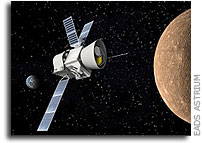BepiColombo Mercury Planetary Orbiter Proto-Flight Mechanical and Propulsion Bus undergoes bake-out

The BepiColombo Mercury Planetary Orbiter Mechanical and Propulsion Bus Proto-Flight Model (the structure with integrated heat pipes and chemical propulsion subsystem) has been baked out in the Phenix thermal vacuum facility at ESA’s European Space Research and Technology Centre (ESTEC) in Noordwijk, the Netherlands.
The BepiColombo Mercury Planetary Orbiter (MPO) Mechanical and Propulsion Bus (MPB) Proto-Flight Model (PFM) has been baked out in the Phenix thermal vacuum facility at ESA’s European Space Research and Technology Centre (ESTEC) in Noordwijk, the Netherlands. This process involved heating the MPB to 60 *C in a vacuum for 20 days to remove any contaminants that would outgas in space. Given the extremes of temperature to which BepiColombo will be exposed – in excess of 350 *C on the parts illuminated by the Sun, -120 *C or less on the parts exposed to cold space – prevention of outgassing is important because the outgassing products from the hot areas of the spacecraft may recondense on colder areas or be photochemically deposited on Sun-illuminated surfaces by ultraviolet radiation.
Contamination of thermal control surfaces would alter their absorptivity / emissivity ratios, possibly causing an uncontrolled increase in temperature. Contamination of the solar arrays could greatly decrease their power output, while contamination of the instruments would severely degrade their optics. Molecular contamination is caused by volatiles that are released by materials such as paints, plastics and adhesives.
The Phenix thermal vacuum facility is designed for small and medium spacecraft and subsystems. The facility consists of a cylindrical vacuum chamber nearly 12 metres long and 4.5 metres in diameter, with access gained through a 4.5-metre-diameter door. The chamber is equipped with a movable box-shaped shroud system and a movable platform on which the test item is mounted. This design enables a quicker throughput time as the movable platform and shroud enable preparation outside the chamber and rapid loading of the facility. Phenix typically achieves a vacuum of 5 10^-6 millibar in the absence of heavily outgassing materials.
The MPB PFM will now be transported to Thales Alenia in Turin for integration of additional equipment and subsystems. These have already been subjected to a similar outgassing treatment.
About BepiColombo
BepiColombo is Europe’s first mission to Mercury. It is scheduled to launch in August 2015 and arrive at Mercury in January 2022. It will endure temperatures in excess of 350 *C and gather data during a one-year nominal mission, with a possible one-year extension. The mission comprises two spacecraft: the Mercury Planetary Orbiter (MPO) and the Mercury Magnetospheric Orbiter (MMO). During the journey to Mercury, the MMO will be shielded from the Sun by the Magnetospheric Orbiter Sunshield and Interface Structure (MOSIF), which also provides the interface between the MMO and the MPO. The fourth component of the composite spacecraft stack is the Mercury Transfer Module (MTM), whose primary task is to provide solar-electric propulsion for the journey to Mercury.
BepiColombo is a joint mission by ESA and the Japan Aerospace Exploration Agency (JAXA), executed under ESA leadership. The Prime Contractor for BepiColombo is Astrium GmbH.








